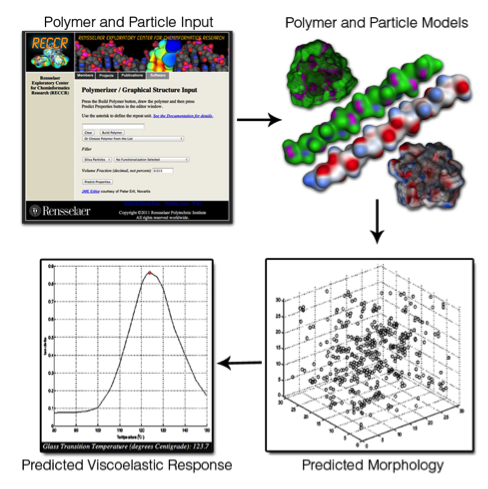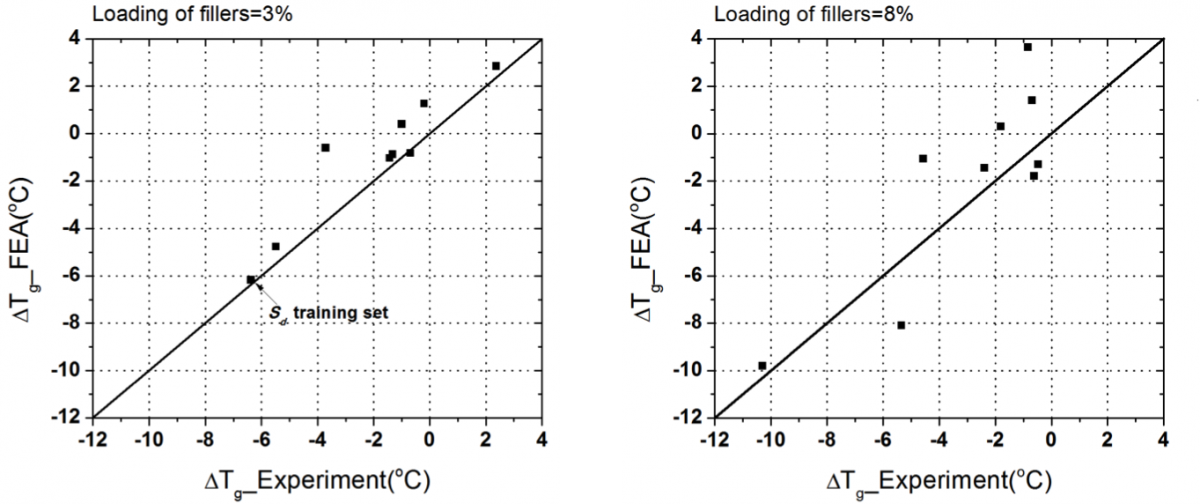FEM analysis of dielectric properties in polymer nanocomposites
Nanodielectrics, or polymer nanocomposite dielectric materials, have demonstrated significant improvements in electrical endurance, breakdown strength and dielectric constant, which leads to enhanced energy storage capabilities. The key role played by the large interfacial area surrounding the nanofillers proves to be essential to the enhancement. Part of this research explores quantitative models to predict the altered dielectric properties in the interfacial area as a function of surface chemistry. Effect of dispersion in microstructure is also investigated, with the impact of morphology of the composites, i.e., the dispersion states of the nanofillers and interphase region, explicitly designated in the FEA model. Using analogy of mathematical formulation between dielectric permittivity and viscoelastic modulus, a simple mathematical conversion enables the usage of the Prony Series that has been extensively documented in viscoelasticity theory to fit the dielectric spectroscopy. With the input morphology and physical property information, the dielectric spectroscopy tests over a range of frequencies can be simulated. The properties of the interfacial region are determined through an iterative comparison between model output and the experimental results. It is observed that the distribution of dielectric relaxation times of the interface could be expressed using those of the polymer matrix multiplied by different frequency shift factors in different systems. Our result indicates that we can use similar methods to characterize interfacial properties of polymer nanodielectrics as in interfacial thermomechanical properties simulation. This method can also provide significant insight to explore the relationship between surface chemistry of nanoparticles and impact on spectroscopy of interfacial properties in nanodielectric materials.
A second aspect in nanodielectrics modeling with FEA is the prediction of dielectric breakdown behavior. Initiation and development of a dielectric breakdown tree is intrinsically a physical problem rendered using random patterns. Even for the same homogeneous material, the breakdown strength varies from sample to sample. Characteristic breakdown strengths of a material are usually taken as the applied external electric field strength which gives a breakdown probability of 63.2% in the experiments. Additionally, since the material properties will change after breakdown, this simulation can also be categorized as a phase transition problem. In this project, we developed the continuum model in COMSOL that combines the FEA solver and a random field method in order to simulate the time-dependent evolution of dielectric breakdown in the composites. This feature provides high flexibility in defining the stochastic breakdown process when well developed constitutive equations are not present.



Viscoelastic Properties of Polymer Nanocomposites and Material Genome Prediction
Accelerated insertion of nanocomposites into advanced applications is predicated on the ability to perform a priori property predictions on the resulting materials. In this work, physics-based continuum models are coupled with heuristic informatics-based approach (MQSPR) and experimental verification to predict the thermomechanical properties of silane-modified spherical nanoparticle filled polymers. The hypothesis driving this strategy is that the dispersion and distribution of the nanofillers as well as the mobility of the polymer chains near the nanoparticles can each be predicted beginning with the polar and dispersive components of the surface energies of the polymer and functionalized nanofillers. From knowledge of the dispersion and distribution of the nanofillers, as well as the relaxation times of the polymers in the nanoparticle/matrix interfacial region, a 3D continuum model can be used to predict the thermomechanical response of the resulting nanocomposites. This methodology can be quantitatively validated from the relationship between parameters, such as glass transition temperature (Tg) and dispersion.




After being validated using best-practices methods, aggregate polymer surface energy models were incorporated into a web-based toolkit to facilitate their use by the broader community, and to provide a front end for our hybrid MQSPR/Finite Element Analysis (FEA) modeling tool. Currently, the MQSPR portion of the both the dispersive and polar bootstrap we determined the tool allows users to compute surface energy components for either existing or designed polymers, which can then be used together with the predictedsurface energy components of the selected nanofiller as part of a larger web-based hybrid tool discussed at the end of the paper.In practice, the web-based toolkit is divided into three major components across two sites: The first provides the user with a simplified front end for designating polymer matrix structures, nanoparticulate core type (silica is the only option at this point) and volume fraction, along with a drop-down menu of nanoparticle surface functionalizations. While stepping through the web-based tool, the user receives information on surface energies, dispersion paramaters and eventually thermomechanical properties. See polymerizer to utilize the webtool.
Relevant Publications:
Yang Li, He Zhao, Ke Wu, Yanhui Huang, Timothy Krentz, Hongyi Xu, Wei Chen, Curt Breneman, Linda Schadler, and Cate Brinson Dielectric Spectroscopy Analysis on Polymer Nanodielectrics Using Homogenization models and FEA Simulation (in preparation)
He Zhao, Yang Li, Xiaolin Li, L Catherine Brinson, Yanhui Huang, Timothy M Krentz, Ke Wu, Curt Breneman, Linda Schadler. Application of finite element modeling and viscoelasticity theory in characterization and prediction of dielectric relaxation process in polymer nanodielectrics. Proceedings of the Society of Engineering Science 51st Annual Technical Meeting, October 1-3, 2014 , West Lafayette: Purdue University
Hongyi Xu; Yang Li; Catherine Brinson; Wei Chen. "A descriptor-based design methodology for developing heterogeneous microstructural materials system," Journal of Mechanical Design, Transactions of the ASME.2014;136(5)
Bharath Natarajan; Yang Li; Hua Deng; L. Catherine Brinson; Linda S. Schadler "Effect of interfacial energetics on dispersion and glass transition temperature in polymer nanocomposites," Macromolecules.2013;46(7):2833-2841.
Curt M. Breneman; L. Catherine Brinson; Linda S. Schadler; Bharath Natarajan; Michael Krein; Ke Wu; Lisa Morkowchuk; Yang Li; Hua Deng; Hongyi Xu "Stalking the materials genome: A data-driven approach to the virtual design of nanostructured polymers," Advanced Functional Materials.2013;23(46):5746-5752.
Michael P. Krein; Bharath Natarajan; Linda S. Schadler; L.C. Brinson; Hua Deng; Donghai Gai; Yang Li; Curt M. Breneman "Development of materials informatics tools and infrastructure to enable high throughput materials design," Materials Research Society Symposium Proceedings.2012;1425:1-6.
Yanhui Huang, Timothy M Krentz, J Keith Nelson, Linda S Schadler, Yang Li, He Zhao, L Catherine Brinson, Michael Bell, Brian Benicewicz, Ke Wu, Curt M Breneman. "Prediction of interface dielectric relaxations in bimodal brush functionalized epoxy nanodielectrics by finite element analysis method". Electrical Insulation and Dielectric Phenomena (CEIDP), 2014 IEEE Conference on